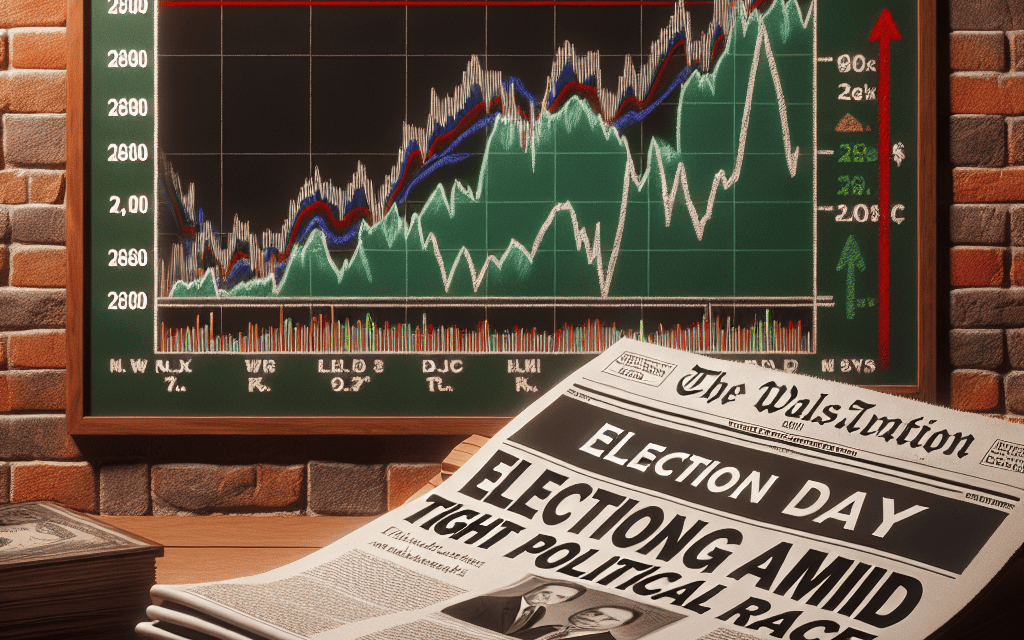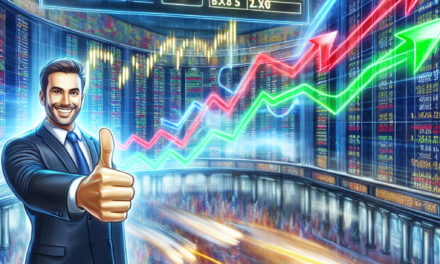“Markets Surge as Election Day Unfolds: Dow Climbs 280 Points in Trump-Harris Showdown”
Introduction
On Election Day, the stock market experienced a notable surge, with the Dow Jones Industrial Average climbing 280 points. This uptick in the market came amid a closely contested presidential race between incumbent President Donald Trump and challenger Kamala Harris. Investors appeared to be reacting to the uncertainty and potential outcomes of the election, with market participants closely monitoring the evolving political landscape. The significant movement in the Dow reflects the broader economic implications tied to the election results, as traders and analysts weigh the potential policy shifts and economic strategies that could emerge from either administration.
Market Reactions: Analyzing the Dow’s 280-Point Surge on Election Day
On Election Day, the Dow Jones Industrial Average experienced a notable surge, climbing 280 points as investors closely monitored the tight race between former President Donald Trump and Vice President Kamala Harris. This unexpected market rally reflects the complex interplay between political events and economic sentiment, underscoring the importance of investor confidence in shaping market dynamics. As the nation awaited the election results, market participants appeared to be reacting to the potential implications of either candidate’s victory on economic policies and future market conditions.
The stock market often serves as a barometer for investor sentiment, and the 280-point increase in the Dow suggests a degree of optimism among investors. This optimism may be attributed to several factors, including the anticipation of policy continuity or change, depending on the election outcome. Historically, markets have shown a preference for predictability and stability, and the prospect of a clear election result may have contributed to the positive market movement. Furthermore, investors might be speculating on the potential for new economic policies that could stimulate growth, such as infrastructure spending or tax reforms, which both candidates have hinted at during their campaigns.
In addition to the political landscape, other economic indicators likely played a role in the Dow’s performance. Recent economic data, including employment figures and consumer spending reports, have shown signs of resilience, suggesting that the economy is on a path to recovery despite ongoing challenges. This resilience may have bolstered investor confidence, leading to increased buying activity in the stock market. Moreover, the Federal Reserve’s commitment to maintaining accommodative monetary policies has provided a supportive backdrop for equities, further encouraging investors to take on risk.
While the election undoubtedly captured the market’s attention, it is essential to consider the broader context in which this rally occurred. Global economic conditions, trade relations, and geopolitical tensions continue to influence market behavior. For instance, ongoing negotiations between major economies on trade agreements and tariffs can have significant implications for multinational corporations and, by extension, the stock market. Additionally, geopolitical developments, such as conflicts or alliances, can impact investor sentiment and market stability.
As the election results unfold, market participants will be closely watching for any indications of policy shifts that could affect various sectors. For example, a Trump victory might lead to continued deregulation and tax cuts, potentially benefiting industries such as energy and finance. Conversely, a Harris win could result in increased focus on renewable energy and healthcare reforms, influencing those respective sectors. Investors will need to assess these potential changes and adjust their portfolios accordingly to mitigate risks and capitalize on opportunities.
In conclusion, the 280-point surge in the Dow on Election Day highlights the intricate relationship between political events and market reactions. While the immediate focus is on the election outcome, investors must remain vigilant in monitoring other economic and geopolitical factors that could influence market trends. As the nation moves forward, the ability to navigate these complexities will be crucial for investors seeking to achieve their financial objectives in an ever-evolving landscape. The market’s response to the election serves as a reminder of the dynamic nature of financial markets and the myriad factors that drive investor behavior.
Election Day Volatility: How the Tight Trump-Harris Race Influenced the Dow
On Election Day, the financial markets were abuzz with activity as the Dow Jones Industrial Average surged by 280 points, reflecting the heightened anticipation and uncertainty surrounding the tight race between former President Donald Trump and Vice President Kamala Harris. This significant uptick in the Dow underscores the intricate relationship between political events and market dynamics, as investors closely monitor electoral outcomes that could influence economic policies and, consequently, market performance.
The election, characterized by its intense competition and polarized voter base, has kept investors on edge, prompting them to recalibrate their portfolios in anticipation of potential policy shifts. Historically, elections have been pivotal moments for the stock market, often leading to increased volatility as traders and investors attempt to predict the implications of a new administration. In this particular race, the stakes are perceived to be exceptionally high, given the contrasting economic agendas of the two candidates. Trump’s platform, with its emphasis on deregulation and tax cuts, appeals to investors seeking a continuation of pro-business policies. Conversely, Harris’s focus on social equity and environmental sustainability suggests a potential shift towards more regulatory oversight and green investments.
As the election results began to trickle in, the market’s initial response was one of cautious optimism. The Dow’s 280-point jump can be attributed to several factors, including investor speculation about the potential for a divided government, which historically has been seen as favorable for markets. A divided government, where different parties control the executive branch and at least one chamber of Congress, often results in legislative gridlock, reducing the likelihood of significant policy changes that could disrupt market stability. This scenario tends to reassure investors, as it suggests a continuation of the status quo, allowing businesses to operate without the immediate threat of sweeping regulatory reforms.
Moreover, the market’s positive response can also be linked to broader economic indicators that have shown resilience despite the political uncertainty. Recent data on consumer spending, employment rates, and corporate earnings have painted a picture of an economy that, while facing challenges, continues to demonstrate underlying strength. This economic backdrop provides a buffer against the potential volatility associated with the election, offering investors a degree of confidence in the market’s ability to weather political transitions.
In addition to domestic factors, global market trends have also played a role in shaping investor sentiment. The international community is closely watching the U.S. election, given its implications for global trade and diplomatic relations. A stable and predictable U.S. administration is seen as crucial for maintaining international economic stability, and the prospect of a clear electoral outcome has contributed to a sense of cautious optimism among global investors.
In conclusion, the Dow’s 280-point rise on Election Day amid the tight Trump-Harris race highlights the complex interplay between political events and market behavior. As investors navigate this period of uncertainty, they are weighing the potential impacts of the election on economic policy and market conditions. While the immediate future remains uncertain, the market’s response suggests a cautious optimism, driven by a combination of domestic economic resilience and the potential for a divided government that could maintain the status quo. As the election results continue to unfold, investors will remain vigilant, ready to adjust their strategies in response to the evolving political landscape.
Investor Sentiment: Understanding the Market’s Response to Political Uncertainty
On Election Day, the Dow Jones Industrial Average surged by 280 points, reflecting a significant shift in investor sentiment amid the closely contested race between former President Donald Trump and Vice President Kamala Harris. This notable uptick in the stock market underscores the intricate relationship between political events and market dynamics, as investors navigate the uncertainties inherent in electoral outcomes. Understanding the market’s response to political uncertainty requires a nuanced appreciation of the factors that drive investor behavior during such pivotal moments.
To begin with, the stock market often serves as a barometer for investor confidence, reacting to both domestic and international political developments. In the context of a tight presidential race, market participants are keenly aware of the potential implications of each candidate’s policies on economic growth, regulatory frameworks, and fiscal strategies. As such, the fluctuations in the Dow Jones Industrial Average on Election Day can be attributed to investors’ attempts to anticipate and position themselves for the possible economic landscapes that could emerge under either a Trump or Harris administration.
Moreover, the market’s response is not solely based on the candidates’ policy proposals but also on the perceived stability and predictability of the political environment. Political uncertainty can lead to increased market volatility, as investors grapple with the potential for abrupt changes in policy direction. In this election, the tight race between Trump and Harris has heightened these uncertainties, prompting investors to closely monitor polling data, electoral forecasts, and any developments that might provide clarity on the likely outcome.
In addition to the immediate political context, broader economic indicators also play a crucial role in shaping investor sentiment. On Election Day, positive economic data, such as robust job growth figures and strong corporate earnings reports, may have contributed to the Dow’s upward trajectory. These indicators can bolster investor confidence by suggesting that the underlying economy remains resilient, even amid political turbulence. Consequently, the interplay between political events and economic fundamentals is a key determinant of market behavior during election periods.
Furthermore, it is important to consider the role of market psychology in driving investor decisions. The stock market is not merely a reflection of economic realities but also a manifestation of collective investor sentiment. During times of political uncertainty, emotions such as fear and optimism can significantly influence market movements. For instance, the prospect of a clear electoral outcome, regardless of the winner, may alleviate some of the anxiety associated with prolonged political indecision, thereby encouraging investors to re-enter the market with renewed confidence.
In conclusion, the 280-point jump in the Dow Jones Industrial Average on Election Day highlights the complex interplay between political uncertainty and investor sentiment. As the tight race between Trump and Harris unfolds, market participants are tasked with deciphering the potential economic implications of each candidate’s policies while contending with the broader uncertainties inherent in the electoral process. By examining the factors that drive market behavior during such critical junctures, investors can gain a deeper understanding of how political events shape the financial landscape and, in turn, make more informed decisions in navigating the ever-evolving market environment.
Historical Comparisons: Election Day Market Movements and Their Impacts
On Election Day, the Dow Jones Industrial Average surged by 280 points, reflecting the market’s response to the tight race between former President Donald Trump and Vice President Kamala Harris. This notable movement in the stock market invites a comparison with historical election day trends, offering insights into how political events can influence financial markets. Historically, election days have been pivotal moments for the stock market, often characterized by heightened volatility as investors react to the potential outcomes and their implications for economic policy.
To understand the significance of the recent 280-point jump, it is essential to examine past election day market movements. Historically, the stock market has shown varied responses to election outcomes, often influenced by the perceived economic policies of the candidates. For instance, the 2008 election, which saw Barack Obama elected as President, was marked by a significant downturn in the market due to the ongoing financial crisis. Conversely, the 2016 election, which resulted in Donald Trump’s victory, initially caused a sharp decline in futures markets but was followed by a substantial rally as investors anticipated business-friendly policies.
The current election day movement can be seen as part of this broader historical pattern, where markets react not only to the immediate results but also to the anticipated policy directions of the candidates. In the case of the Trump-Harris race, investors are likely weighing the potential impacts of each candidate’s economic agenda. Trump’s policies, characterized by tax cuts and deregulation, have historically been viewed favorably by the market. On the other hand, Harris’s platform, which includes increased government spending on infrastructure and social programs, may be seen as a catalyst for economic growth, albeit with potential concerns about increased regulation and taxation.
Moreover, the market’s reaction on election day is often influenced by the level of uncertainty surrounding the outcome. In tightly contested races, such as the current one, the uncertainty can lead to increased volatility as investors adjust their portfolios in anticipation of different scenarios. This phenomenon was evident in the 2000 election between George W. Bush and Al Gore, where the prolonged uncertainty due to the Florida recount led to significant market fluctuations.
In addition to the immediate election day movements, it is crucial to consider the longer-term impacts of election outcomes on the stock market. Historically, markets tend to stabilize and even rally in the months following an election, as the initial uncertainty dissipates and investors gain clarity on the policy direction. This pattern underscores the importance of looking beyond the immediate market reactions to understand the broader economic implications of an election.
In conclusion, the 280-point jump in the Dow on election day amid the tight Trump-Harris race is a reflection of historical trends where markets respond to political events with a mix of volatility and anticipation. By examining past election day movements and their impacts, investors can gain valuable insights into how political outcomes may shape economic policy and influence market dynamics. As the election results unfold, the focus will likely shift to the specific policy measures implemented by the winning candidate and their potential effects on the economy and financial markets.
Economic Indicators: What the Dow’s Jump Means for Future Market Trends
On Election Day, the Dow Jones Industrial Average surged by 280 points, reflecting investor sentiment amid the closely contested race between former President Donald Trump and Vice President Kamala Harris. This significant uptick in the Dow serves as a barometer for market confidence, suggesting that investors are optimistic about the economic policies that may emerge from the election outcome. As the nation awaits the final results, the stock market’s performance provides valuable insights into potential future market trends and economic indicators.
The Dow’s rise can be attributed to several factors, including investor anticipation of policy stability and economic growth. Historically, markets tend to favor predictability, and the prospect of a clear election outcome, regardless of the winner, often leads to increased investor confidence. In this context, the 280-point jump indicates that investors are hopeful for a resolution that will bring clarity to the economic landscape. Moreover, the market’s performance on Election Day underscores the importance of political stability in fostering a conducive environment for economic growth.
In addition to political factors, the Dow’s performance is also influenced by broader economic indicators. For instance, recent data on consumer spending and employment rates have shown signs of recovery, contributing to the positive market sentiment. As consumer confidence grows, so does the potential for increased economic activity, which in turn bolsters market performance. Furthermore, the Federal Reserve’s monetary policy, characterized by low interest rates and quantitative easing measures, continues to provide a supportive backdrop for the stock market. These economic indicators collectively paint a picture of cautious optimism, which is reflected in the Dow’s upward trajectory.
However, it is essential to consider the potential challenges that may impact future market trends. The ongoing global supply chain disruptions and inflationary pressures pose significant risks to economic stability. Investors are keenly aware of these issues, and their potential to affect corporate earnings and consumer prices. As such, the market’s current optimism may be tempered by these uncertainties, necessitating a careful analysis of how these factors might evolve in the coming months. The interplay between these economic challenges and the political landscape will be crucial in shaping future market trends.
Moreover, the outcome of the Trump-Harris race could have profound implications for fiscal policy, trade relations, and regulatory frameworks. Each candidate’s approach to these issues will influence investor sentiment and market dynamics. For instance, a focus on infrastructure spending and green energy initiatives could stimulate certain sectors, while changes in trade policies might affect global supply chains and international markets. As investors assess the potential impact of these policies, the Dow’s performance will serve as a key indicator of market expectations and confidence.
In conclusion, the 280-point jump in the Dow Jones Industrial Average on Election Day reflects a complex interplay of political and economic factors. While the market’s performance suggests optimism about the future, it is essential to remain vigilant about the challenges that lie ahead. As the election results unfold and new policies are implemented, investors will continue to monitor economic indicators and market trends closely. The Dow’s movement serves as a valuable gauge of investor sentiment, providing insights into the potential direction of the economy in the post-election landscape.
Political Influence: The Role of Elections in Shaping Market Dynamics
On Election Day, the Dow Jones Industrial Average surged by 280 points, reflecting the intricate relationship between political events and market dynamics. This notable increase in the stock market index underscores the profound influence that elections can have on investor sentiment and economic forecasts. As the nation focused on the tight race between former President Donald Trump and Vice President Kamala Harris, market participants were keenly aware of the potential implications of the election outcome on fiscal policies, regulatory changes, and international trade agreements.
The stock market often serves as a barometer for investor confidence, and its fluctuations can be attributed to a myriad of factors, including political developments. In this context, the anticipation surrounding the election results played a pivotal role in driving market activity. Investors, analysts, and economists closely monitored the unfolding political landscape, attempting to gauge the potential impact of each candidate’s policy proposals on various sectors of the economy. The prospect of changes in taxation, government spending, and regulatory frameworks can significantly influence corporate profitability and, consequently, stock valuations.
Moreover, the election’s outcome holds substantial implications for international relations and trade policies, which are critical components of market stability. A Trump victory could signal a continuation of his administration’s approach to trade, characterized by a focus on bilateral agreements and a more protectionist stance. Conversely, a Harris win might suggest a shift towards multilateralism and a potential recalibration of trade relationships. These divergent paths could affect global supply chains, tariffs, and market access, thereby impacting the financial performance of multinational corporations and the broader market.
In addition to policy considerations, the election’s influence on market dynamics is also shaped by the psychological aspect of investor behavior. Elections inherently introduce a degree of uncertainty, which can lead to increased market volatility. Investors often react to perceived risks and opportunities, adjusting their portfolios in response to the evolving political environment. The tight race between Trump and Harris heightened this sense of uncertainty, prompting market participants to reassess their strategies and hedge against potential outcomes.
Furthermore, the role of media coverage and public discourse in shaping market perceptions cannot be overlooked. The extensive media attention surrounding the election amplified its significance, with news outlets providing real-time updates and analyses that influenced investor sentiment. This constant flow of information contributed to the market’s responsiveness, as investors sought to align their decisions with the latest developments.
It is also important to consider the broader economic context in which this election took place. The global economy has been navigating a complex landscape marked by recovery efforts from the COVID-19 pandemic, inflationary pressures, and geopolitical tensions. These factors add layers of complexity to the election’s impact on market dynamics, as investors weigh the potential for policy shifts against the backdrop of existing economic challenges.
In conclusion, the 280-point jump in the Dow Jones Industrial Average on Election Day serves as a testament to the significant role that elections play in shaping market dynamics. The interplay between political developments, investor sentiment, and economic forecasts creates a multifaceted environment in which market participants must navigate. As the nation awaits the final election results, the financial markets will continue to reflect the intricate balance of risks and opportunities inherent in this pivotal moment.
Financial Strategies: Navigating Market Fluctuations During Election Periods
The stock market often experiences heightened volatility during election periods, as investors grapple with the uncertainty surrounding potential policy changes and their implications for various sectors. On Election Day, the Dow Jones Industrial Average surged by 280 points, reflecting investor sentiment amid the closely contested race between former President Donald Trump and Vice President Kamala Harris. This uptick in the market underscores the importance of understanding how political events can influence financial strategies and the need for investors to navigate these fluctuations with a well-informed approach.
Historically, elections have been pivotal moments for the stock market, with outcomes often leading to shifts in fiscal and regulatory policies that can impact corporate earnings and economic growth. As such, investors tend to react to the perceived economic agendas of the candidates, adjusting their portfolios in anticipation of potential changes. In the current election cycle, the tight race between Trump and Harris has added an extra layer of complexity, as both candidates present distinct economic visions that could shape the market’s trajectory in different ways.
Trump’s platform, characterized by tax cuts and deregulation, has traditionally been viewed favorably by the market, particularly benefiting sectors such as energy, finance, and manufacturing. On the other hand, Harris’s focus on infrastructure investment, healthcare reform, and clean energy initiatives suggests a shift towards sectors that align with sustainable growth and social equity. Consequently, investors are closely monitoring the election results to gauge which sectors might experience growth or face challenges under the new administration.
In light of these dynamics, financial strategists emphasize the importance of diversification as a key strategy to mitigate risks associated with election-induced market volatility. By spreading investments across a range of asset classes and sectors, investors can reduce their exposure to any single economic policy shift. Moreover, maintaining a long-term perspective is crucial, as short-term market reactions often do not reflect the underlying fundamentals of the economy or the long-term potential of individual companies.
Additionally, investors are advised to stay informed about the broader economic indicators that can influence market performance during election periods. Factors such as interest rates, inflation, and global trade dynamics play a significant role in shaping market sentiment and can either amplify or dampen the effects of political developments. By keeping abreast of these indicators, investors can make more informed decisions and adjust their strategies accordingly.
Furthermore, it is essential for investors to remain vigilant and adaptable in the face of unexpected developments. The current election cycle has been marked by unprecedented challenges, including the ongoing impact of the COVID-19 pandemic and geopolitical tensions, which have further complicated the investment landscape. As such, having a flexible approach and being prepared to adjust strategies in response to new information is vital for navigating the uncertainties of election periods.
In conclusion, the 280-point jump in the Dow on Election Day highlights the intricate relationship between political events and market performance. As the Trump-Harris race unfolds, investors must remain cognizant of the potential implications for their portfolios and employ strategies that account for both the opportunities and risks presented by the election outcome. By focusing on diversification, staying informed about economic indicators, and maintaining a flexible approach, investors can better navigate the market fluctuations that accompany election periods and position themselves for long-term success.
Q&A
1. **What was the main event on the day the Dow jumped 280 points?**
– The main event was the U.S. Election Day, featuring a tight race between Donald Trump and Kamala Harris.
2. **How many points did the Dow Jones Industrial Average increase?**
– The Dow Jones Industrial Average increased by 280 points.
3. **What was the nature of the race mentioned in the context of the Dow’s performance?**
– The race was a tight electoral contest between Donald Trump and Kamala Harris.
4. **What was the market sentiment on Election Day?**
– The market sentiment was positive, as indicated by the rise in the Dow Jones Industrial Average.
5. **Which two political figures were highlighted in the election race?**
– The political figures highlighted were Donald Trump and Kamala Harris.
6. **What impact did the election have on the stock market?**
– The election had a positive impact, with the Dow Jones Industrial Average jumping 280 points.
7. **Was the increase in the Dow Jones Industrial Average attributed to any specific factors?**
– The increase was attributed to the anticipation and reactions surrounding the tight election race.
Conclusion
On Election Day, the Dow Jones Industrial Average surged by 280 points, reflecting investor optimism or uncertainty amid a closely contested race between then-President Donald Trump and Vice Presidential candidate Kamala Harris. This market movement suggests that investors were reacting to potential election outcomes and their implications for economic policy, trade, and regulatory environments. The tight race likely contributed to market volatility, as investors weighed the prospects of different policy directions under either administration. Overall, the market’s positive response indicates a complex interplay of factors influencing investor sentiment during a pivotal political event.





